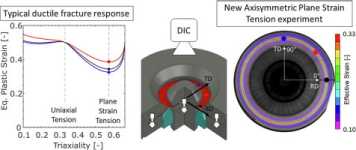New Paper on "Axisymmetric V-Bending
Our new paper on "Axisymmetric V-Bending: a Single Experiment to Determine the Fracture Strain and Weakest Sheet Material Direction for Plane Strain Tension" was published in International Journal of Solids and Structures
external pageplease refer to Sciencedirect to review the full article
Abstract

Most metals exhibit a critical minimum in ductility for plane strain tension. The fracture strain for this particular state of loading is an important reference point for the calibration of ductile fracture models. Here, an axisymmetric V-bending technique is proposed to identify the strain to fracture for plane strain tension for the weakest in-plane direction of sheet metal. After clamping the center and outer boundary of a disc specimen onto an axisymmetric fixture, the specimen is drawn over a tubular knife until fracture initiates on the specimen surface. Throughout the experiment, the specimen surface is monitored with a digital camera for timely crack detection and strains measurement by planar Digital Image Correlation (DIC). It is shown through numerical simulations that the experimental setup is remarkably robust with the results exhibiting a low sensitivity to geometric imperfections. Experiments are performed on aluminum AA2024 and two dual phase steels (DP780 and DP 980) to demonstrate the validity of the proposed technique through comparison with conventional V-bending and dihedral mini-Nakazima experiments.
